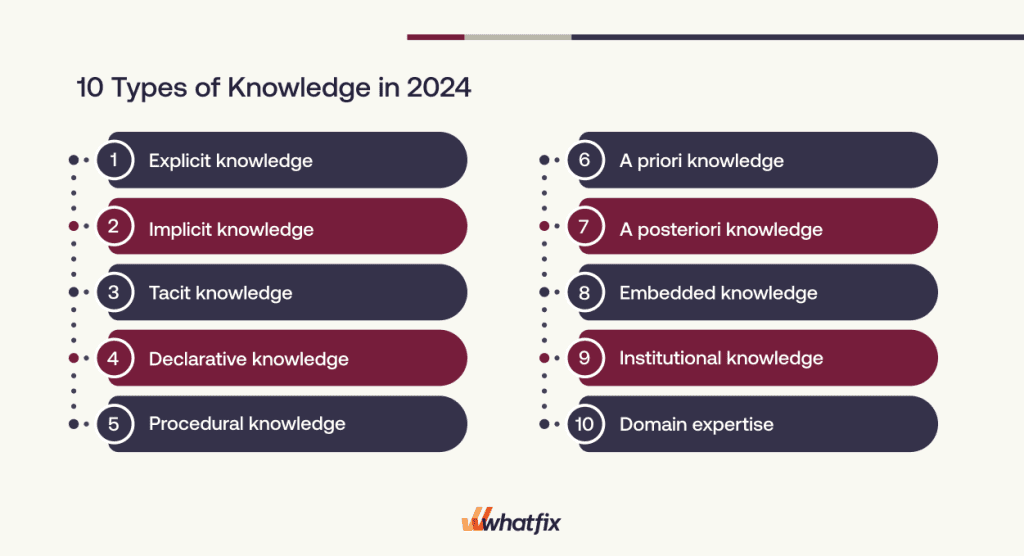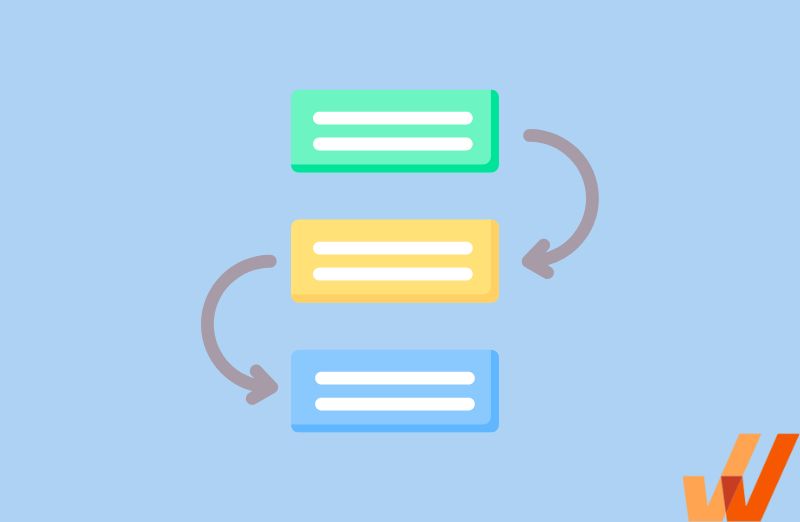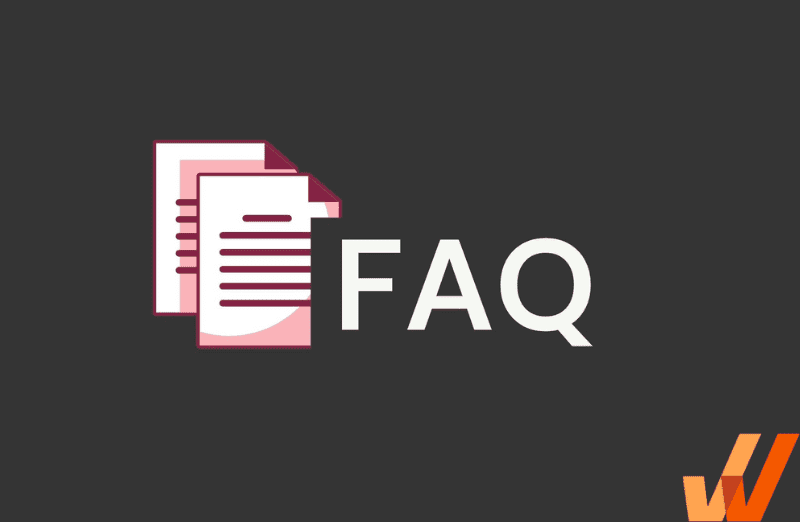Your entire organization is built upon knowledge. Knowledge is acquired, transferred, and implemented in all company processes, like hiring new employees, creating ITIL processes, your company culture, your products and services, etc.
However, not all knowledge is the same. The type of knowledge depends on its context and influences how it is shared, applied, and retained within an organization. Understanding these different types of knowledge—explicit, implicit, and tacit—helps leaders and teams harness the full potential of their collective expertise.
By recognizing and leveraging the unique characteristics of each type of knowledge, organizations can foster a more collaborative, informed, and agile work environment, ultimately driving success and growth.
In this article, we will study the different types of knowledge, breaking down each to provide clear examples, characteristics, and workplace applications for each knowledge type.
10 Types of Knowledge in 2025
- Explicit knowledge
- Implicit knowledge
- Tacit knowledge
- Declarative knowledge
- Procedural knowledge
- A priori knowledge
- A posteriori knowledge
- Embedded knowledge
- Institutional knowledge
- Domain expertise
What Is Knowledge?
Knowledge is the collection of information, skills, and insights that individuals acquire through education, experience, and interactions. It encompasses facts, concepts, and practical know-how, enabling people to understand and navigate the world around them. Knowledge management is essential for problem-solving, decision-making, and innovation, making it a critical asset for individuals and organizations.
The 10 Types of Knowledge Explained
Here are the most common types of knowledge.

1. Explicit knowledge
Explicit knowledge is easily articulated, documented, and shared. It includes information codified in books, manuals, databases, and other formalized structures.
Explicit knowledge is systematic and easily transferable between individuals or groups, making it the most accessible form. This knowledge can be readily communicated through language, symbols, diagrams, and other forms of documentation.
Examples of explicit knowledge:
- A company’s training manual that outlines the procedures for using a particular software is an example of explicit knowledge. Employees can easily refer to the manual to understand how to perform specific tasks.
- Standard operating procedures (SOPs) that provide detailed, step-by-step instructions on how to complete specific tasks or processes.
- Software development documentation, such as API guides or system architecture diagrams, is explicit knowledge developers can use to understand and work with the software.
- A comprehensive knowledge base or FAQ page with well-documented how-to’s and support content.
- Customer case studies that highlight the value and ROI of a partnership.
Characteristics of explicit knowledge:
- Codifiable: It’s easily documented, stored, and transferred.
- Accessible: Available in formats that can be found and used by others.
- Structured: Organized to make it easy to navigate and understand.
- Reproducible: Can be consistently applied across different contexts without losing its value.
Applications of explicit knowledge in the workplace:
- Knowledge transfer: Facilitates training and development and helps ensure critical knowledge is passed on to new employees or across teams.
- Consistency and standardization: Helps maintain process governance and consistent decision-making across the organization.
- Efficiency and productivity: Reduces the time and effort needed to perform tasks by providing clear instructions and guidelines.
- Compliance and risk management: Ensures employees follow legal and regulatory requirements, reducing non-compliance risk.
2. Implicit knowledge
Implicit knowledge is the practical application of explicit knowledge. People often develop the know-how through experience and practice without consciously thinking about it.
Implicit knowledge is not as quickly articulated as explicit knowledge but can be inferred from actions and decisions. While it’s derived from explicit knowledge, implicit knowledge is more intuitive and often remains unspoken.
Examples of implicit knowledge:
- General problem-solving skills formed over time by experiencing and overcoming various challenges and tasks.
- Customer service representatives who know the exact tone and approach when dealing with an upset customer.
- Sales professionals’ knowledge of how to manage a customer relationship based on each client’s needs, preferences, and behavior.
- A manager prioritizes tasks or delegates responsibilities based on the team dynamics.
- An engineer knows which tools or techniques to fix a recurring issue based on years of experience with similar problems.
Characteristics of implicit knowledge:
- Context-specific: Highly dependent on the company’s environment, relationships, sector, and situations.
- Develops over time: Acquired through years of experience, making it unique to the individual.
- Informally transferred: Implicit knowledge is often passed down informally through peer-to-peer learning, mentoring, and learning experiences.
Applications of implicit knowledge in the workplace:
- Innovation and creativity: Employees rely on their implicit knowledge to think outside the box and creatively solve problems without clear directions or documentation.
- Cultural fit: Understanding and aligning with the implicit cultural norms of the organization can improve collaboration, employee satisfaction, and retention.
- Crisis management: In high-stakes situations with no clear precedent, implicit knowledge enables quick, effective decision-making.
3. Tacit knowledge
Tacit knowledge is deeply embedded in individual experience and intuition, making it difficult to articulate or transfer to others. It includes insights, intuitions, and skills that are often learned through personal experience or social interactions rather than formal instruction.
Tacit knowledge is often subconscious and is passed on through observation, practice, and shared experiences rather than through written or verbal communication.
Examples of tacit knowledge:
- Effective leadership often relies on tacit knowledge, such as the ability to read a room, inspire a team, or navigate complex interpersonal dynamics.
- A seasoned product manager’s uncanny ability to predict market trends.
- A veteran developer’s intuition for identifying potential bugs in a new product release.
- A long-term employee’s deep understanding of the company’s culture, unwritten rules, and social norms that helps them navigate the workplace effectively and foster positive relationships with colleagues.
Characteristics of tacit knowledge:
- Personal and context-specific: Tacit knowledge is deeply rooted in individual experience and is often specific to a particular context or environment.
- Difficult to articulate: Tacit knowledge is often subconscious and not easily expressed in words or documentation.
- Gained through experience: Tacit knowledge is acquired over time through hands-on experience, trial and error, and personal reflection.
- Intuitive and informal: This knowledge often involves intuition, insights, and hunches that are developed informally rather than through structured learning.
- Mentorship and job shadowing: Tacit knowledge is often transferred informally through mentorship programs, where experienced employees guide newcomers by demonstrating tasks and sharing personal insights.
Applications of tacit knowledge in the workplace:
- Innovation and problem-solving: Employees rely on their tacit knowledge to develop innovative solutions and tackle complex problems requiring more straightforward answers. This creative problem-solving is crucial for driving innovation in the workplace.
- Crisis management: In high-pressure situations, tacit knowledge enables quick, effective decision-making. Experienced employees can use their intuition and past experiences to navigate crises successfully.
- Building strong experiences: Leaders with deep tacit knowledge of team dynamics can build stronger, more cohesive teams by understanding individual strengths, fostering collaboration, and creating a positive work environment.
4. Declarative knowledge
Declarative knowledge, often called “know-what,” is understanding factual information, concepts, and truths. It encompasses the knowledge of facts, definitions, theories, and principles that can be explicitly stated and communicated.
This foundational knowledge forms the basis for further learning and understanding various fields. In the workplace, declarative knowledge is essential for roles that require a strong sense of specific concepts or facts, such as in education, research, or any field where information must be analyzed, explained, or taught.
Examples of declarative knowledge:
- Knowledge of key dates, events, and milestones in the company’s history. For instance, knowing when the company was founded, major product launches, or significant mergers and acquisitions.
- Detailed information about a company’s products, such as technical specifications, features, and benefits. For example, a salesperson’s knowledge of the specifications of a particular model of a laptop they are selling.
- Understanding of the rules, laws, and standards that govern the industry in which the company operates. For example, an HR manager’s knowledge of employment laws and compliance requirements.
- Familiarity with the specific terms, jargon, and definitions used within a particular field or organization. For example, a finance professional’s knowledge of accounting terms like “liabilities,” “assets,” and “equity.”
Characteristics of declarative knowledge:
- Fact-based: Declarative knowledge consists of factual information and is often concerned with the “what” rather than the “how” or “why.” It involves understanding and recalling specific data, concepts, and definitions.
- Easily communicated: This type of knowledge can be easily articulated, documented, and shared with others through language, whether in written or spoken form.
- Formalized: Declarative knowledge is typically well-organized and structured, making it suitable for formal education, training programs, and documentation.
- Foundational: Declarative knowledge serves as the foundation for more complex types of knowledge, such as procedural or implicit knowledge. It provides the basic understanding needed to perform tasks or engage in higher-order thinking.
Applications of declarative knowledge in the workplace:
- Training and education: Declarative knowledge is crucial in employee onboarding and training programs, where employees learn about company policies, product details, and industry-specific regulations.
- Decision-making: Managers and employees rely on declarative knowledge when making informed decisions. For instance, a manager’s knowledge of past sales data can inform future marketing strategies.
- Compliance and risk management: Declarative knowledge is essential to ensure the company adheres to legal and regulatory requirements.
5. Procedural knowledge
Procedural knowledge refers to the understanding of how to perform specific tasks or processes through a series of steps or actions. It is practical and action-oriented and is typically acquired through hands-on experience, practice, and repetition, making it essential for tasks that require a certain level of skill and precision.
Procedural knowledge is often sequential, following a logical order that ensures tasks are completed correctly and efficiently. This knowledge is foundational in manufacturing, customer service, project management, and any other domain where specific procedures must be followed to achieve desired outcomes.
Examples of procedural knowledge:
- Knowledge of operating specific software applications, such as Excel for data analysis or Photoshop for graphic design.
- The step-by-step knowledge of operating machinery and producing goods in a manufacturing setting.
- The procedure for handling customer inquiries, complaints, and returns.
- Knowledge of managing a project from start to finish, including planning, execution, monitoring, and closing.
Characteristics of procedural knowledge:
- Action-oriented: Procedural knowledge focuses on “how” to perform tasks or procedures, emphasizing the steps or actions required to achieve a specific outcome.
- Developed through practice: This knowledge is typically acquired through repeated practice and hands-on experience rather than theoretical learning.
- Context-specific: Procedural knowledge is often tailored to specific tools, environments, or situations, primarily applicable within those contexts.
- Sequential and logical: Procedural knowledge follows a sequence of logically ordered steps to ensure tasks are performed correctly and efficiently.
Applications of procedural knowledge in the workplace:
- Employee training and development: Procedural knowledge is critical in training programs where employees learn how to perform specific tasks, such as using equipment and software, or following safety protocols.
- Operational efficiency: Procedural knowledge ensures that tasks are performed consistently and correctly, which is essential for maintaining operational efficiency.
- Problem-solving: Employees use procedural knowledge to troubleshoot and resolve issues that arise during their work.
- Standardization and compliance: Procedural knowledge supports standardization across the organization, ensuring that processes are followed consistently.
6. A priori knowledge
A priori knowledge is independent of experience, relying instead on reasoning and logical deduction. It is the knowledge considered universally true and can be known through thought alone, without the need for empirical evidence or sensory experience.
This knowledge is foundational in mathematics, philosophy, and logic, where certain truths are accepted as self-evident and do not require external validation. In the workplace, a priori knowledge might underpin certain principles or guidelines accepted as universally valid, serving as the basis for decision-making, problem-solving, and theoretical frameworks.
Examples of priori knowledge:
- Ability to excel in mathematics or logical reasoning due to their natural ability to understand and interpret information without further explanation.
- An individual’s inherent ability to recognize patterns and solve complex problems without extensive training or prior experience.
- An individual’s ability to instinctively distinguish between right and wrong and make ethical decisions without requiring detailed ethical training.
Characteristics of priori knowledge:
- Independent of experience: A priori knowledge is known to be true without empirical evidence or sensory experience. It is understood through reasoning and logical deduction.
- Universal and necessary: This knowledge is considered universally valid and applies in all cases without exception.
- Foundational reasoning: A priori knowledge provides the foundational principles for further rationale, theories, and knowledge. It serves as the basis for deductive reasoning and theoretical frameworks.
Applications of priori knowledge in the workplace:
- Theoretical frameworks: In research and development, a priori knowledge is used to develop theoretical models and frameworks that guide exploring new ideas.
- Decision-making: A priori knowledge is applied in decision-making processes requiring logical reasoning. For example, in strategic planning, leaders may use logical deductions to anticipate outcomes and make decisions that do not solely rely on empirical data.
- Policy and rule formation: Organizations use a priori knowledge to create policies and rules that are universally applicable, such as ethical guidelines or legal principles.
- Philosophical and ethical reasoning: In areas such as corporate ethics and governance, a priori knowledge is applied to reason about what is right or wrong, fair or unfair, often without needing empirical evidence to support these judgments.
7. A posteriori knowledge
A posteriori knowledge is derived from experience and empirical evidence. Unlike a priori knowledge, which is based on reasoning independent of experience, a posteriori knowledge is gained through observation, experimentation, and sensory experience.
This type of knowledge is often used in scientific research, data analysis, and practical decision-making, where outcomes are determined by testing hypotheses against real-world data. A posteriori knowledge is fundamental in areas that require validation through evidence, making it crucial for understanding and navigating complex environments where direct experience informs understanding.
Examples of posteriori knowledge:
- A company’s knowledge of consumer preferences and purchasing behavior, derived from analyzing survey data and sales trends, is a posteriori knowledge.
- Understanding an employee’s effectiveness based on observed performance metrics and feedback is an example of a posteriori knowledge.
- Learning that a product needs improvement based on customer reviews and feedback is a form of a posteriori knowledge, as it relies on real-world data to inform decisions.
Characteristics of posteriori knowledge:
- Experience-based: A posteriori knowledge is derived from direct experience, observation, and empirical evidence rather than theoretical reasoning alone.
- Empirical validation: This knowledge requires verification through experiments, data analysis, and sensory experience, and it can change if new evidence emerges.
- Context-sensitive: A posteriori knowledge is often specific to particular situations, environments, or conditions, as it is based on real-world occurrences.
- Dynamic and evolving: Since it depends on empirical evidence, a posteriori knowledge can evolve as new data is gathered and previous conclusions are reevaluated.
Applications of posteriori knowledge in the workplace:
- Data-driven decision-making: A posteriori knowledge is crucial in making informed business decisions based on data analysis and market research, such as product development or marketing strategies.
- Quality control and improvement: In manufacturing or service delivery, a posteriori knowledge helps identify areas for improvement based on observed defects, customer complaints, or performance issues.
- Employee development: Performance evaluations and professional growth plans are often based on a posteriori knowledge from observing employee behavior, achievements, and feedback over time.
- Risk management: Organizations use a posteriori knowledge to manage risks by analyzing past incidents, failures, and successes. This empirical knowledge helps develop strategies to mitigate future risks and improve operational resilience.
8. Embedded knowledge
Embedded knowledge is ingrained within an organization’s processes, systems, products, and culture. It is often not explicitly documented but is integral to the organization’s functioning and success. This knowledge is reflected in the way things are done within the company, such as operational workflows, technology platforms, and organizational routines.
Embedded knowledge is difficult to extract and transfer because it is built into the organization’s fabric, often through years of practice, cultural norms, and accumulated expertise. It supports the consistency and efficiency of operations, enabling the organization to maintain quality and achieve strategic goals.
Examples of embedded knowledge:
- A company’s project management software automatically assigning tasks and deadlines based on previous projects and team member capabilities is an example of embedded knowledge, as it reflects the organization’s accumulated experience in managing projects.
- The specific steps and machine settings used in a manufacturing process that consistently produces high-quality products are embedded knowledge developed and refined over time.
- The unspoken rules and behavioral expectations within a company, such as decision-making processes or communication styles, are embedded knowledge that influences how employees interact and perform their roles.
- A CRM system that automatically suggests customer interaction strategies based on historical data and customer behavior patterns reflects embedded knowledge of successful sales practices within the organization.
Characteristics of embedded knowledge:
- Context-specific: Embedded knowledge is closely tied to an organization’s specific processes, systems, and culture, making it unique to that particular context.
- Not easily articulated: This knowledge is often implicit and complex to document or transfer because it is embedded within organizational routines and technology.
- Integral to operations: Embedded knowledge is crucial for the smooth functioning of organizational processes and is often a key factor in maintaining operational consistency and efficiency.
- Evolves: This type of knowledge develops and accumulates through experience and practice, becoming more refined and effective as it adapts to the organization’s changing needs.
Applications of embedded knowledge in the workplace:
- Operational efficiency: Embedded knowledge ensures that workflows and processes are optimized for efficiency. For example, an automated supply chain system that adjusts orders based on past demand patterns helps streamline operations and reduce waste.
- Consistency in quality: By embedding knowledge into manufacturing processes or service delivery protocols, organizations can maintain consistent quality in their products or services.
- Decision-making: Managers and leaders rely on embedded knowledge when making strategic decisions, providing a foundation built on the organization’s accumulated experience and best practices.
9. Institutional knowledge
Institutional knowledge refers to the collective understanding, skills, processes, and historical context that an organization accumulates over time. This type of knowledge is often undocumented and resides in the minds of long-standing employees or is embedded within the organization’s culture and practices.
Institutional knowledge encompasses everything from the company’s founding history to its decision-making processes, internal policies, and unwritten norms. It is critical to maintaining continuity, ensuring smooth operations, and preserving the organization’s identity.
Examples of institutional knowledge:
- Knowledge of how the company was established, including the original mission, vision, and challenges faced by the founders.
- Understanding the history of key customer accounts, including past interactions, preferences, and the nuances of relationship management.
- Detailed knowledge of how certain internal processes were developed and refined and why specific methods are used.
- The shared beliefs, norms, and values cultivated over the years, guiding employee behavior and decision-making.
Characteristics of institutional knowledge:
- Collective and cumulative: Institutional knowledge is the sum of the experiences, decisions, and practices accumulated over time within an organization.
- Often undocumented: Much of institutional knowledge needs to be formally recorded, making it reliant on the memory and experience of long-term employees. It includes unwritten rules, informal procedures, and historical context that may need to be captured in official documents.
- Crucial for continuity: This knowledge is essential for maintaining operational continuity, especially during transitions, such as when key employees retire or leave the organization.
- Embedded in culture: Institutional knowledge is deeply embedded in the organization’s culture, influencing how employees interact, make decisions, and approach their work.
Applications of institutional knowledge in the workplace:
- Succession planning: Institutional knowledge is crucial for preparing new organizational leaders. It ensures that successors understand the historical context, key relationships, and the rationale behind current strategies, allowing for a smooth leadership transition.
- Crisis management: During crises, institutional knowledge provides valuable insights into how similar situations were handled in the past, helping the organization respond effectively.
- Onboarding and training: During the onboarding process, new employees are exposed to institutional knowledge, helping them understand the company’s culture, values, and unwritten rules.
- Strategic decision-making: Leaders rely on institutional knowledge to make informed decisions that align with the company’s long-term goals and values. This knowledge helps ensure that decisions are consistent with the organization’s history and culture, maintaining strategic coherence.
10. Domain expertise
Domain expertise knowledge refers to the deep, specialized understanding and skills an individual possesses in a particular field or industry. This type of knowledge is gained through extensive experience, education, and continuous learning within a specific domain, making the individual an expert or authority in that area.
Domain expertise is critical for solving complex problems, making informed decisions, and driving innovation within a particular field. It encompasses the theoretical knowledge of the subject and the practical application and nuances that are often only learned through years of dedicated practice.
Examples of domain knowledge:
- An investment banker with extensive knowledge of financial markets, valuation techniques, and risk management strategies. This expertise allows them to make informed decisions on mergers and acquisitions, investment opportunities, and financial structuring.
- A software engineer with deep expertise in AI, machine learning algorithms, and data science, capable of developing advanced AI models and systems that drive innovation in technology companies.
- A healthcare administrator with specialized knowledge in hospital operations, healthcare regulations, patient care protocols, and health informatics, enabling them to manage and improve healthcare delivery effectively.
Characteristics of domain knowledge:
- Deep and specialized: Domain expertise is characterized by a profound and highly specialized understanding of a specific field or industry, often encompassing both theoretical and practical aspects.
- Acquired over time: This knowledge is developed through years of dedicated study, experience, and continuous learning within a particular domain. It is not easily transferable to other fields.
- Highly valued and sought after: Individuals with domain expertise are often considered authorities in their field and are highly valued for their ability to solve complex problems and provide expert insights.
Applications of domain knowledge in the workplace:
- Strategic decision-making: Leaders and managers rely on domain expertise to make informed decisions that require specialized knowledge. For example, a CTO with domain expertise in cybersecurity can make critical decisions about protecting company data and infrastructure.
- Innovation and problem-solving: Domain experts drive innovation by applying their deep knowledge to develop new solutions, products, or services.
- Mentorship and knowledge sharing: Domain experts play a crucial role in mentoring less experienced colleagues and sharing their knowledge within the organization.
Additional Knowledge FAQs
What is a Knowledge Base?
A knowledge base serves as a tool for employees and users to find accurate information when required. It’s a digital vault for your resources, including onboarding & training materials or guided software tutorials.
What Is Knowledge Management?
Knowledge management is the systematic method of creating, capturing, organizing, storing, and sharing essential information to become more efficient. The main goal of knowledge management is to connect employees seeking knowledge and solutions to the correct information as quickly as possible.
What are the key knowledge management factors?
Ensure you take the following elements into account when designing your knowledge management strategy:
- People and Culture
- Process
- Technology
- Strategy
How to build knowledge management strategy for your workplace?
A knowledge management strategy helps you identify what knowledge you need to manage and keep your project on track.
- Build your knowledge management team
- Identify your knowledge goals
- Perform a knowledge audit
- Choose your technology
- Create a communication plan
- Establish milestones
- Build a roadmap
Large organizations rely on mission-critical enterprise software to maintain day-to-day operations and achieve business objectives. Employees are responsible for using these tools to complete tasks. To drive business process adoption and completion rates, organizations can use a digital adoption platform (DAP) like Whatfix to provide in-app performance support, in the flow of work.
With Whatfix DAP, you can:
- Accelerate time-to-proficiency for new hires and during software implementation projects with Tours and Task Lists.
- Enable employees to master complex processes and complete infrequently done tasks with Flows.
- Nudge users to take certain actions or remind them of additional knowledge with Smart Tips.
- Support employees on-demand with Self Help, an in-app resource center that integrates with your knowledge repositories to directly provide employees with performance support in the digital workplace.
- Communicate important announcements like company news, product updates, new campaigns, process changes, upcoming deadlines, and new training resources with Pop-Ups.
- Improve data quality by providing contextual Field Validations.
- Collect user feedback on training experiences, help understand sentiment, bug identification, and more with in-app Surveys.
- Understand how employees consume and engage with your in-app content with Guidance Analytics.
Additionally, use Whatfix Mirror to create replica sandbox environments of your enterprise software and its custom workflows to provide hands-on user training that enables employees to maximize their efficiency and master tasks, accelerates adoption rates, and improves technology ROI.
Software clicks better with Whatfix. Request a demo today!













